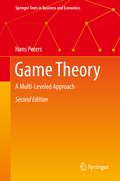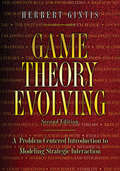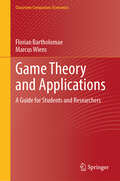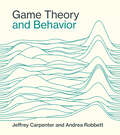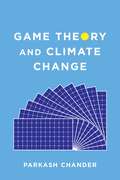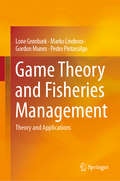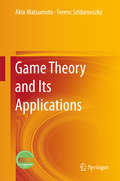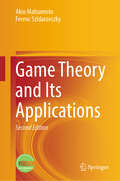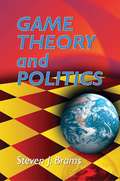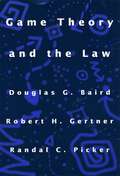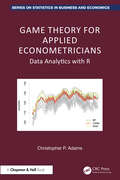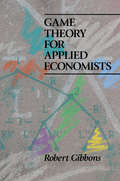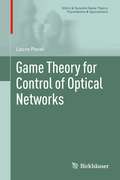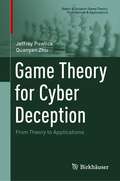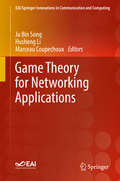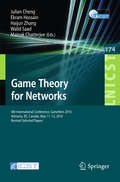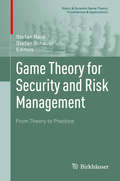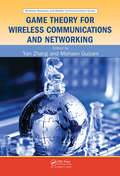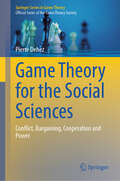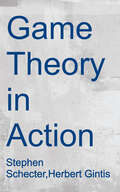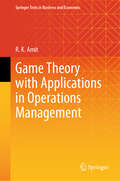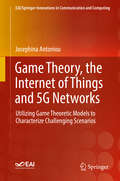- Table View
- List View
Game Theory
by Michael Maschler Eilon Solan Shmuel ZamirCovering both noncooperative and cooperative games, this comprehensive introduction to game theory also includes some advanced chapters on auctions, games with incomplete information, games with vector payoffs, stable matchings and the bargaining set. Mathematically oriented, the book presents every theorem alongside a proof. The material is presented clearly and every concept is illustrated with concrete examples from a broad range of disciplines. With numerous exercises the book is a thorough and extensive guide to game theory from undergraduate through graduate courses in economics, mathematics, computer science, engineering and life sciences to being an authoritative reference for researchers.
Game Theory
by Hans PetersThis textbook presents the basics of game theory both on an undergraduate level and on a more advanced mathematical level. It is the second, revised version of the successful 2008 edition. The book covers most topics of interest in game theory, including cooperative game theory. Part I presents introductions to all these topics on a basic yet formally precise level. It includes chapters on repeated games, social choice theory, and selected topics such as bargaining theory, exchange economies, and matching. Part II goes deeper into noncooperative theory and treats the theory of zerosum games, refinements of Nash equilibrium in strategic as well as extensive form games, and evolutionary games. Part III covers basic concepts in the theory of transferable utility games, such as core and balancedness, Shapley value and variations, and nucleolus. Some mathematical tools on duality and convexity are collected in Part IV. Every chapter in the book contains a problem section. Hints, answers and solutions are included.
Game Theory Evolving: A Problem-Centered Introduction to Modeling Strategic Interaction - Second Edition
by Herbert GintisSince its original publication in 2000, Game Theory Evolving has been considered the best textbook on evolutionary game theory. This completely revised and updated second edition of Game Theory Evolving contains new material and shows students how to apply game theory to model human behavior in ways that reflect the special nature of sociality and individuality. The textbook continues its in-depth look at cooperation in teams, agent-based simulations, experimental economics, the evolution and diffusion of preferences, and the connection between biology and economics. Recognizing that students learn by doing, the textbook introduces principles through practice. Herbert Gintis exposes students to the techniques and applications of game theory through a wealth of sophisticated and surprisingly fun-to-solve problems involving human and animal behavior. The second edition includes solutions to the problems presented and information related to agent-based modeling. In addition, the textbook incorporates instruction in using mathematical software to solve complex problems. Game Theory Evolving is perfect for graduate and upper-level undergraduate economics students, and is a terrific introduction for ambitious do-it-yourselfers throughout the behavioral sciences. Revised and updated edition relevant for courses across disciplines Perfect for graduate and upper-level undergraduate economics courses Solutions to problems presented throughout Incorporates instruction in using computational software for complex problem solving Includes in-depth discussions of agent-based modeling
Game Theory and Applications: A Guide for Students and Researchers (Classroom Companion: Economics)
by Florian Bartholomae Marcus WiensThis textbook provides an overview of the fundamentals of game theory and its applications in various fields. It introduces game theory as an established toolkit for the mathematical analysis and evaluation of strategic decisions. Through applied exercises, it introduces the basic concepts of game theory and offers students from various disciplines the opportunity to practice the concepts through in-depth training. The textbook addresses advanced students of economics, business administration, and related disciplines, university graduates with basic mathematical training as well as interested readers from all fields. For this, it provides student-friendly explanations, a variety of exercises and problems, and useful references to further reading. The book is divided into a beginner-friendly theory section, in which the most important aspects are presented in a compact and clear manner, and an application-oriented problem section, in which the readers can directly check what they have learned and find many application examples. The latter can also be used as a source of inspiration for instructors.
Game Theory and Behavior
by Jeffrey Carpenter Andrea RobbettAn introduction to game theory that offers not only theoretical tools but also the intuition and behavioral insights to apply these tools to real-world situations.This introductory text on game theory provides students with both the theoretical tools to analyze situations through the logic of game theory and the intuition and behavioral insights to apply these tools to real-world situations. It is unique among game theory texts in offering a clear, formal introduction to standard game theory while incorporating evidence from experimental data and introducing recent behavioral models. Students will not only learn about incentives, how to represent situations as games, and what agents &“should&” do in these situations, but they will also be presented with evidence that either confirms the theoretical assumptions or suggests a way in which the theory might be updated.Features:Each chapter begins with a motivating example that can be run as an experiment and ends with a discussion of the behavior in the example.Parts I–IV cover the fundamental &“nuts and bolts&” of any introductory game theory course, including the theory of games, simple games with simultaneous decision making by players, sequential move games, and incomplete information in simultaneous and sequential move games.Parts V–VII apply the tools developed in previous sections to bargaining, cooperative game theory, market design, social dilemmas, and social choice and voting.Part VIII offers a more in-depth discussion of behavioral game theory models including evolutionary and psychological game theory.Supplemental material on the book&’s website include solutions to end-of-chapter exercises, a manual for running each chapter&’s experimental games using pencil and paper, and the oTree codes for running the games online.
Game Theory and Climate Change
by Parkash ChanderDespite the growing consensus on the need for action to counteract climate change, complex economic and political forces have so far prevented international actors from making much headway toward resolving the problem. Most approaches to climate change are based in economics and environmental science; in this book, Parkash Chander argues that we can make further progress on the climate change impasse by considering a third approach—game theory.Chander shows that a game-theoretic approach, which offers insight into the nature of interactions between sovereign countries behaving strategically and the kinds of outcomes such interactions produce, can illuminate how best to achieve international agreements in support of climate-change mitigation strategies. Game Theory and Climate Change develops a conceptual framework with which to analyze climate change as a strategic or dynamic game, bringing together cooperative and noncooperative game theory and providing practical analyses of international negotiations. Chander offers economic and game-theoretic interpretations of both the Kyoto Protocol and the Paris Agreement and argues that the Paris Agreement may succeed where the Kyoto Protocol failed. Finally, Chander discusses the policy recommendations his framework generates, including a global agreement to support development of cleaner technologies on a global scale.
Game Theory and Fisheries Management: Theory and Applications
by Lone Grønbæk Marko Lindroos Gordon Munro Pedro PintassilgoThis book is the first to present in a systematic manner the application of game theory to fisheries management at both international and national levels. Strategic interaction among fishers and nations exploiting fishery resources is an inescapable fact of life. This has long been recognized at the international level, and is becoming increasingly recognized at the national/regional level. It follows, therefore, that, in order to be able to analyse effectively the management of these resources, the theory of strategic interaction ̶ game theory ̶ must be brought to bear. In this book the step-by-step development of the game theory is accompanied by numerous applications to the real world of fisheries management policy. As such, it is designed to appeal to policy makers and stakeholders, as well as to graduate students in Economics.
Game Theory and Its Applications
by Ferenc Szidarovszky Akio MatsumotoThis book integrates the fundamentals, methodology, and major application fields of noncooperative and cooperative games including conflict resolution. The topics addressed in the book are discrete and continuous games including games represented by finite trees; matrix and bimatrix games as well as oligopolies; cooperative solution concepts; games under uncertainty; dynamic games and conflict resolution. The methodology is illustrated by carefully chosen examples, applications and case studies which are selected from economics, social sciences, engineering, the military and homeland security. This book is highly recommended to readers who are interested in the in-depth and up-to-date integration of the theory and ever-expanding application areas of game theory.
Game Theory and Its Applications
by Ferenc Szidarovszky Akio MatsumotoThis book integrates the fundamentals, methodology, and major application fields of noncooperative and cooperative games including conflict resolution. The topics addressed in the book are discrete and continuous games including games represented by finite trees; matrix and bimatrix games as well as oligopolies; cooperative solution concepts; games under uncertainty; dynamic games; and conflict resolution. The methodology is illustrated by carefully chosen examples and applications, and the case studies are selected from economics, social sciences, engineering, the military, and homeland security. This book is highly recommended to readers who are interested in the in-depth and up-to-date integration of the theory and ever-expanding application areas of game theory. Dynamic games with and without delays and partial cooperation are added in the 2nd edition.
Game Theory and Politics
by Steven J. BramsIn this illuminating and instructive survey, author Steven J. Brams demonstrates both the insights and the pitfalls that can result from applying game theoretic models to the analysis of problems in political science. Using plenty of real-life examples, Brams shows how game theory can explain and elucidate complex political situations, from warfare to presidential vetoes. In these cases and others, game theory's mathematical structure provides a rigorous, consistent method for formulating, analyzing, and solving strategic problems. Minimal mathematical background is necessary, making the book accessible to a wide audience of students and teachers of politics and social science, as well as other readers with a serious interest in politics. New preface to the Dover edition. 1975 edition.
Game Theory and the Law
by Douglas G. Baird Robert H. Gertner Randal C. PickerThis book is the first to apply the tools of game theory and information economics to advance our understanding of how laws work. Organized around the major solution concepts of game theory, it shows how such well known games as the prisoner’s dilemma, the battle of the sexes, beer-quiche, and the Rubinstein bargaining game can illuminate many different kinds of legal problems. Game Theory and the Law highlights the basic mechanisms at work and lays out a natural progression in the sophistication of the game concepts and legal problems considered.
Game Theory for Applied Econometricians: Data Analytics with R (Chapman and Hall/CRC Series on Statistics in Business and Economics)
by Christopher P. AdamsOver the last 30 years the practice and use of game theory has changed dramatically, yet textbooks continue to present game theory with algebraic formalism and toy models. This book, on the other hand, illustrates game theory concepts using real-world data and analyses problems with real policy implications. The focus is on applying current learning to real world problems by providing an introduction to game theory and econometric analysis based on game theoretic principles using the computer language R.The book covers the standard topics of an introductory game theory course including dominant strategies, Nash equilibrium and Bayes Nash equilibrium. It layers on top of this an approach to statistics and econometrics called Structural Modeling. In this approach, key parameter estimates rely upon game theoretic analysis. The real-world examples used to illustrate these concepts vary in scope and include an analysis of bargaining between hospitals and insurers, equilibrium entry of retail tire stores, bid rigging in timber auctions and contracts in 19th century whaling.This book is aimed at the general reader with the equivalent of a bachelor’s degree in economics, statistics or some more technical field. The book could be used as a text for an upper level undergraduate course or a lower level graduate course in economics or business.
Game Theory for Applied Economists
by Robert S. GibbonsThis book introduces one of the most powerful tools of modern economics to a wide audience: those who will later construct or consume game-theoretic models. Robert Gibbons addresses scholars in applied fields within economics who want a serious and thorough discussion of game theory but who may have found other works overly abstract. Gibbons emphasizes the economic applications of the theory at least as much as the pure theory itself; formal arguments about abstract games play a minor role. The applications illustrate the process of model building--of translating an informal description of a multi-person decision situation into a formal game-theoretic problem to be analyzed. Also, the variety of applications shows that similar issues arise in different areas of economics, and that the same game-theoretic tools can be applied in each setting. In order to emphasize the broad potential scope of the theory, conventional applications from industrial organization have been largely replaced by applications from labor, macro, and other applied fields in economics. The book covers four classes of games, and four corresponding notions of equilibrium: static games of complete information and Nash equilibrium, dynamic games of complete information and subgame-perfect Nash equilibrium, static games of incomplete information and Bayesian Nash equilibrium, and dynamic games of incomplete information and perfect Bayesian equilibrium.
Game Theory for Control of Optical Networks
by Lacra PavelOptical networks epitomize complex communication systems, and they comprise the Internet's infrastructural backbone. The first of its kind, this book develops the mathematical framework needed from a control perspective to tackle various game-theoretical problems in optical networks. In doing so, it aims to help design control algorithms that optimally allocate the resources of these networks. With its fresh problem-solving approach, Game Theory in Optical Networks is a unique resource for researchers, practitioners, and graduate students in applied mathematics and systems/control engineering, as well as those in electrical and computer engineering.
Game Theory for Cyber Deception: From Theory to Applications (Static & Dynamic Game Theory: Foundations & Applications)
by Quanyan Zhu Jeffrey PawlickThis book introduces game theory as a means to conceptualize, model, and analyze cyber deception. Drawing upon a collection of deception research from the past 10 years, the authors develop a taxonomy of six species of defensive cyber deception. Three of these six species are highlighted in the context of emerging problems such as privacy against ubiquitous tracking in the Internet of things (IoT), dynamic honeynets for the observation of advanced persistent threats (APTs), and active defense against physical denial-of-service (PDoS) attacks. Because of its uniquely thorough treatment of cyber deception, this book will serve as a timely contribution and valuable resource in this active field. The opening chapters introduce both cybersecurity in a manner suitable for game theorists and game theory as appropriate for cybersecurity professionals. Chapter Four then guides readers through the specific field of defensive cyber deception. A key feature of the remaining chapters is the development of a signaling game model for the species of leaky deception featured in honeypots and honeyfiles. This model is expanded to study interactions between multiple agents with varying abilities to detect deception. Game Theory for Cyber Deception will appeal to advanced undergraduates, graduate students, and researchers interested in applying game theory to cybersecurity. It will also be of value to researchers and professionals working on cybersecurity who seek an introduction to game theory.
Game Theory for Managing Security in Chemical Industrial Areas (Advanced Sciences and Technologies for Security Applications)
by Genserik Reniers Laobing ZhangThis book systematically studies how game theory can be used to improve security in chemical industrial areas, capturing the intelligent interactions between security managers and potential adversaries. The recent unfortunate terrorist attacks on critical infrastructures show that adversaries are intelligent and strategic. Game theoretic models have been extensively used in some domains to model these strategic adversaries. However, there is a lack of such advanced models to be employed by chemical security managers. In this book, game theoretic models for protecting chemical plants as well as clusters are proposed. Different equilibrium concepts are explored, with user-friendly explanation of how to reflect them to realistic cases. Based on efficient analysis of the properties of security issues in chemical plants/clusters, models in this book are capable to support resources allocations, cost-effectiveness analysis, cooperation incentives and alike.
Game Theory for Networking Applications (EAI/Springer Innovations in Communication and Computing)
by Husheng Li Ju Bin Song Marceau CoupechouxThis book provides recent results of game theory for networking applications. The contributors address the major opportunities and challenges in applying traditional game theory as well as intelligent game theory to the understanding and designing of modern network systems, with emphasis on both new analytical techniques and novel application scenarios. After an overview of game theory for networks, the book narrows in on game theory in communications, game theory in wireless networks, and game theory applications. The book features contributions from researchers and professionals around the world.Presents a variety of perspectives on game theory for networking applications;Shows how game theory can apply to the study of data traffic, new generation networks, and smartgrid;Includes recent results of applied game theory for networks, providing some technical progresses in GAMENETS.
Game Theory for Networks
by Walid Saad Ekram Hossain Haijun Zhang Julian Cheng Mainak ChatterjeeThis book constitutes the refereed proceedings of the 6th International Conference on Game Theory for Networks, GameNets 2016, held in Kelowna, Canada, in May 2016. The 13 papers were carefully selected from 26 submissions and cover topics such as algorithmic game theory, game models and theories, game theories in wireless networks, design and analysis of economic games.
Game Theory for Security and Risk Management: From Theory to Practice (Static & Dynamic Game Theory: Foundations & Applications)
by Stefan Rass Stefan SchauerThe chapters in this volume explore how various methods from game theory can be utilized to optimize security and risk-management strategies. Emphasizing the importance of connecting theory and practice, they detail the steps involved in selecting, adapting, and analyzing game-theoretic models in security engineering and provide case studies of successful implementations in different application domains. Practitioners who are not experts in game theory and are uncertain about incorporating it into their work will benefit from this resource, as well as researchers in applied mathematics and computer science interested in current developments and future directions.The first part of the book presents the theoretical basics, covering various different game-theoretic models related to and suitable for security engineering. The second part then shows how these models are adopted, implemented, and analyzed. Surveillance systems, interconnected networks, and power grids are among the different application areas discussed. Finally, in the third part, case studies from business and industry of successful applications of game-theoretic models are presented, and the range of applications discussed is expanded to include such areas as cloud computing, Internet of Things, and water utility networks.
Game Theory for Wireless Communications and Networking (Wireless Networks And Mobile Communications Ser.)
by Yan Zhang Mohsen GuizaniThis comprehensive technical guide explains game theory basics, architectures, protocols, security, models, open research issues, and cutting-edge advances and applications. Describing how to employ game theory in infrastructure-based wireless networks and multihop networks to reduce power consumption, it facilitates quick and easy reference to related optimization and algorithm methodologies. The book explains how to apply the game theoretic model to address resource allocation, congestion control, attacks, routing, energy management, packet forwarding, and MAC.
Game Theory for the Social Sciences: Conflict, Bargaining, Cooperation and Power (Springer Series in Game Theory)
by Pierre DehezThis textbook introduces fundamental concepts of game theory and demonstrates its uses and application in the social sciences. Written in plain English and without overwhelming mathematical jargon, it serves as an invaluable resource for undergraduate students in economics, law, political sciences, and related social sciences. Starting from non-cooperative games and progressing to cooperative games, it explores a wide range of topics, including the analysis of zero-sum games, voting rules and their practical implications, and other applications of game theory. Uniquely, it emphasizes cooperative concepts and their normative applications, providing a fresh perspective. With "Game Theory for the Social Sciences", readers will be equipped with the analytical tools to analyze conflict resolution, bargaining strategies, cooperative decision-making, and the dynamics of power relationships. Through engaging examples drawn from real-world scenarios, readers will develop a solid understanding of how game theory can be applied to diverse fields in social sciences. “Pierre Dehez offers a consistent kit of classic game theoretic tools, from equilibrium concepts to bargaining solutions and power indices, all illustrated with insightful examples and applications.” Françoise Forges, Professor of Economics, Université Paris Dauphine-PSL “This book is written clearly and pedagogically without resorting to difficult mathematics. It provides many different and interesting examples from problems of fair sharing, bargaining to voting systems and many others. It is a perfect introduction to this subject too often quoted but too often misunderstood.” Alan Kirman, Directeur d’études, Ecole des Hautes Etudes en Sciences Sociales, Paris, and Emeritus Professor, Aix-Marseille University
Game Theory in Action: An Introduction to Classical and Evolutionary Models
by Herbert Gintis Stephen SchecterGame Theory in Action is a textbook about using game theory across a range of real-life scenarios. From traffic accidents to the sex lives of lizards, Stephen Schecter and Herbert Gintis show students how game theory can be applied in diverse areas including animal behavior, political science, and economics. <P><P> The book's examples and problems look at such fascinating topics as crime-control strategies, climate-change negotiations, and the power of the Oracle at Delphi. The text includes a substantial treatment of evolutionary game theory, where strategies are not chosen through rational analysis, but emerge by virtue of being successful. This is the side of game theory that is most relevant to biology; it also helps to explain how human societies evolve.
Game Theory in Wireless and Communication Networks
by Tamer Başar Zhu Han Dusit Niyato Walid Saad Are HjørungnesThis unified treatment of game theory focuses on finding state-of-the-art solutions to issues surrounding the next generation of wireless and communications networks. Future networks will rely on autonomous and distributed architectures to improve the efficiency and flexibility of mobile applications, and game theory provides the ideal framework for designing efficient and robust distributed algorithms. This book enables readers to develop a solid understanding of game theory, its applications and its use as an effective tool for addressing wireless communication and networking problems. The key results and tools of game theory are covered, as are various real-world technologies including 3G networks, wireless LANs, sensor networks, dynamic spectrum access and cognitive networks. The book also covers a wide range of techniques for modeling, designing and analysing communication networks using game theory, as well as state-of-the-art distributed design techniques. This is an ideal resource for communications engineers, researchers, and graduate and undergraduate students.
Game Theory with Applications in Operations Management (Springer Texts in Business and Economics)
by R. K. AmitThis book provides a broad picture of solution concepts that are highly applicable to operations and supply chain settings and to explicate these concepts with some of the relevant problems in operations management in multi-agent settings. It discusses different strategic situations like games in normal form, games in extensive form, games of incomplete information, mechanism design, and cooperative games, to solve operations problems of supply chain coordination, capacity planning, revenue and pricing management, and other complex problems of matching supply with demand. The recognition and adoption of game-theoretic modeling for operations and supply chain management problems in multi-agent settings have been a hallmark of operations and supply chain literature research during the last few years. Despite research in operations and supply chain management having embraced both non-cooperative and cooperative game-theoretic solution concepts, there is still an abundance of underutilized concepts and tools in game theory that could strongly influence operations management problems. Additionally, with the increasing digitization of operations and supply chain management, the narrative of problems in these areas focuses on blockchain and smart contracts, platforms, and shared economy. The book profits from these new issues being predominantly multi-agent settings and lending themselves to game-theoretical solution concepts. The book's intended audience is the advanced undergraduate and graduate student community of operations and supply chain management, economics, mathematics, computer science, and industrial engineering. It is also relevant for the research community and industry practitioners who use multi-agent architecture in business problems.
Game Theory, the Internet of Things and 5G Networks: Utilizing Game Theoretic Models to Characterize Challenging Scenarios (EAI/Springer Innovations in Communication and Computing)
by Josephina AntoniouThis book shows how to model selected communication scenarios using game theory. The book helps researchers specifically dealing with scenarios motivated by the increasing use of the Internet of Things (IoT) and 5G Communications by using game theory to approach the study of such challenging scenarios. The author explains how game theory acts as a mathematical tool that models decision making in terms of strategies and mechanisms that can result in optimal payoffs for a number of interacting entities, offering often antagonistic behaviors. The book explores new technologies in terms of design, development and management from a theoretical perspective, using game theory to analyze strategic situations and demonstrate profitable behaviors of the cooperative entities. The book identifies and explores several significant applications/uses/situations that arise from the vast deployment of the IoT. The presentation of the technological scenarios is followed in each of the first four chapters by a step-by-step theoretical model often followed by equilibrium proof, and numerical simulation results, that are explained in a tutorial-like manner. The four chapters tackle challenging IoT and 5G related issues, including: new security threats that IoT brings, e.g. botnets, ad hoc vehicular networks and the need for trust in vehicular communications, content repetition by offloading traffic onto mobile users, as well as issues due to new wearable devices that enable data collection to become more intrusive.

